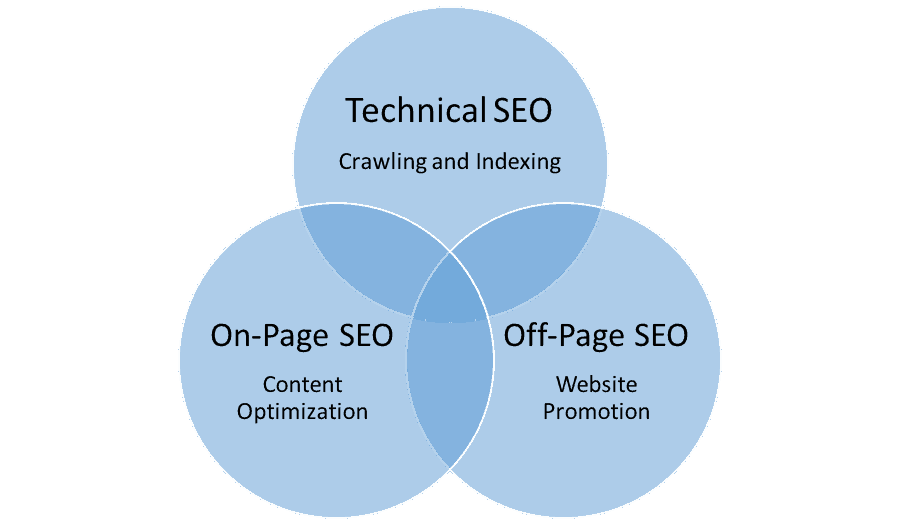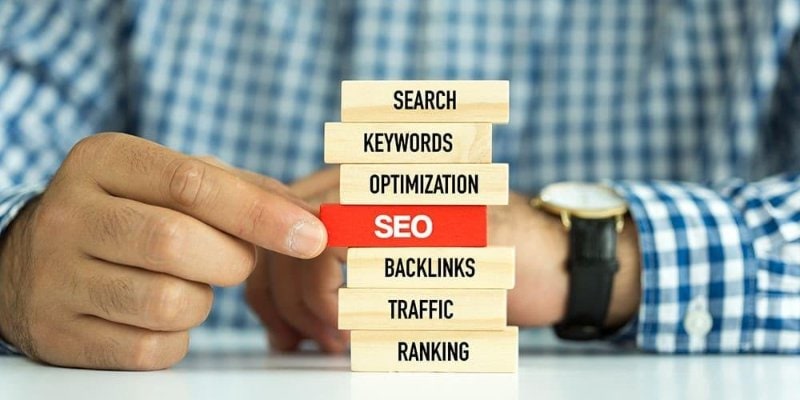Search Engine Optimization or SEO is a complex process that has a number of different types. All SEO types have the same goal: To optimize a website for greater visibility in search engines.
In this post you will learn the different types of SEO and what SEO techniques are applicable for each type.
Types of SEO
Let’s start with a quick definition of what is SEO.
SEO is the process of making a website easier to understand by search engines and friendlier for users. The overall goal of SEO is to increase organic traffic from search engines by improving the positions the website appears in the SERPS for various search terms.
At the beginning (think early 2000), SEO was simple but over the years the whole SEO process has become complex.
When optimizing a website for search engines, you have to consider hundreds of rules to satisfy the various search engine ranking factors and at the same time keep your users happy.
To make it easier to handle, the SEO industry has come with different types of SEO. Each type is responsible for a number of SEO rules.
What is important to understand is that these subsets of SEO are not a different process, it’s just a way of breaking down a complicated process in several smaller processes that are easier to manage.
So, the various SEO types are:
The most important are Technical, On Page and Off Page SEO as shown in the diagram below.

Recommended Reading: Our SEO Checklist covers all types of SEO. For each type you get a checklist of the most important factors you should know about.
Technical SEO
Technical SEO is exactly what the name implies i.e. technical parameters that affect the visibility of a website in search engines.
The main goal of technical SEO is to ensure that search engine crawlers can crawl and index a website without any problems.
The most important technical SEO guidelines are:
- Check and optimize your robots.txt to make sure that search engines can correctly access your website.
- Add and verify your website with Google Search Console and specify your preferred domain.
- Use the COVERAGE report to find and fix crawl errors.
- Create an XML Sitemap and submit to all major search engines.
- Optimize your site structure and URL structure.
- Follow SEO Friendly web design
- Create websites that load fast on both desktop and mobile devices.
On-Page SEO
On Page SEO has to do with the page itself and how to make it friendlier to search engines and users.
It should be noted that while search engines look at a website as a whole, ranking is performed on a page level basis.
That’s why it’s important to pay attention to the optimization of each and every page on your website.
The most important on-page SEO guidelines are:
Optimize your page titles. This is a critical SEO factor. Page titles are shown in the search results and should be interesting for users to click. The title of a page should also give search engine bots enough clues on what the page content is all about.
Optimize your H1 Tag. While the page title is shown in the SERPS, the H1 tag is what is shown as the top heading of a page. An optimized page has only one H1 tag and usually it has the same values as the page title.
Optimize your headings. Besides the H1 tag a page needs to have sub headings (H2, H3) for the different sections. In case of long form content, subheadings make the page easier to read by users and scan by crawlers.
SEO for Images. Any images used on a page should be properly optimized, otherwise search engines cannot understand what they represent. Things like optimizing the filename, file size and ALT text are critical for image SEO.
Page formatting. Publishing a page with text and images without spending time to beautify the content is not a good SEO practice. Although Google cannot ‘see’ a page like a human, they have ways to understand how a page looks or if it’s full of ads and popups and this is taken into account during the ranking process.
Content SEO
Content SEO is a subset of on-page SEO. Content SEO is all about the quality of the content and how to make it better.
Because this is a very important SEO success factor, it is considered by many as one of the types of SEO. In many cases though, you can find content guidelines under on-page SEO, which is also a correct approach.
Publishing great content that users love and search engines can understand, is the winning combination.
To achieve this, you can follow these guidelines:
Start your content creation process with keyword research. Find the SEO keywords that are important for your website and incorporate them in your content.
Go one step further and look for long-tail keywords and semantically related (or LSI) keywords, and add them to your titles, headings and main content.
Publish content that is thorough and long enough so that users can get what they want and search engines to have enough clues to understand the context of your content.
Link out to other high-quality websites (if it makes sense) and to other pages of your website to help users learn more about a topic.
Make use of schemas and structured data to pinpoint to search engines important parts of your content.
Off Page SEO
Off-page SEO is all about promotion. While the previous SEO types concentrated more on the website infrastructure and content, off-page SEO has to do with techniques you can use to promote your website on the Internet.
Websites that are popular are more likely to rank higher on Google than less popular websites.
The most important off-page SEO methods are:
Link Building. Link building is the process of getting SEO backlinks from other websites.
These backlinks act as ‘votes of trust’ and increase the authority of the target website (provided that they don’t have the nofollow attribute attached to the link).
Brand Promotion. Google likes to rank known brands high in the results because people trust them.
Besides promoting your website to get backlinks, you should also work on promoting your brand and encourage conversations about it in the various social media networks and forums.
Google can pick up these signals and reward websites that people talk about.
Local SEO
Local SEO is a type of SEO suited for local businesses only.
In other words, if you have a website and your goal is to get clients visiting your local store, then you should optimize your website for local SEO.
Everything that is mentioned above is valid for Local SEO, with the addition of the following guidelines:
Make sure that you have your business name, address, contact details on all pages of your website.
- Add the Local Business schema on your homepage
- Create a Google My Business Account
- Register your business with trusted directories such as Yelp, Yahoo small business, Foursquare and other.
- Promote your website on local directories and websites (for example online local newspapers).
Recommend Reading: Our local SEO checklist covers in detail everything you need to know about Local SEO optimization.
Mobile SEO
Mobile SEO is again not a different type on its own, but a subset of SEO specific for mobile devices.
It’s a fact that more than 60% of Google searches are now performed on mobile devices.
This is a huge number and a good indication that the Internet is moving away from the traditional desktop and goes to mobile devices.
This is also the reason that Google decided to create a mobile-first index and start indexing the mobile friendly version of a website instead of the desktop version.
When working on Mobile SEO, you need to make sure that:
- Your website is mobile friendly. Running the mobile friendly test is a good starting point.
- The website loads fast on mobile.
- The website is easy to use on mobile.
- The user experience on mobile is not disturbed by interstitial banners, other methods of aggressive advertising or popups.
eCommerce SEO
eCommerce is a huge industry. When it comes to search engine optimization, optimizing an ecommerce website is more complex than working on a blog or corporate website.
You have way more pages to optimize and it’s much more difficult to promote an ecommerce website.
The most important ecommerce SEO factors are:
- Optimization of an online shop starts with the homepage and category pages. These two page types have to properly optimized before you start working on your product pages.
- Optimize your product pages based on the results of your keyword research.
- Optimize ALL visual elements of your store (images, videos)
- Add the necessary schemas (product, offers etc.)
- Promote your store on social media networks
- Think of creative ways to get people to link to your product pages
- Start a blog and publish content related to your products and how they can help people solve a problem.
Recommended Reading: Check out our ecommerce SEO checklist to find out how to fully optimize your ecommerce website.
White Hat SEO vs Black Hat SEO
Is black hat SEO a type of SEO?
Some people consider ‘black hat SEO’ as being a type of SEO and this creates a confusion for beginners.
Black hat SEO is just a term that is used to describe any actions taken to trick search engine algorithms.
From time to time a lot of people come up with ideas on how to artificially create links to improve the rankings of a website on Google. These methods are against Google guidelines and should be avoided.
The only outcome from following black hat techniques is to lose your Google rankings and trust, get penalized by Google and diminish your chances of achieving any rankings in Google ever again.
All the methods described in the article are ‘White Hat SEO’ techniques and if you follow them correctly, you will eventually be able to rank high on search engines and get a portion of the search engine traffic.
Key Learnings
SEO is one of the most powerful digital marketing tools for any type of website. An SEO optimized website enjoys high visibility in Search engines and improves the user experience.
To make it easier to handle, the SEO process is broken down into a number of sub-processes or types. The most important types are Technical SEO, On-Page SEO and Off-Page SEO.





Very nice article.
New types of SEO categories.
Lovely.
First of all thanks for this superb article. In this article, you cover very necessary steps for SEO. I think one point is missing in this article and that is multilingual SEO. If you will cover it in the next article, that might be good for all.
Your blog is full of knowledge, I always found something new which helped me alot. Content marketing is the best way to rank on the Top, i just noted your points, will Follow them. Thanks for sharing your knowledge with us.
Your blog is very nice Thanks for sharing information
Extraordinary. I’ve learned a lot. Hopefully I’ll order your SEO courses soon.
Thanks for enlighten me more about types of SEO. I have subscribed to your blog and I would like to be emailed about more updates on SEO.
Thanks
Thanks for sharing this clear, concise article. SEO is paramount for many businesses. Especially during this pandemic. Many businesses will need to shift 100% to online, and as such SEO and being visible online will become more important then ever.
Your blog is very informative and I’ve always learned something new from your blogs, which has been extremely beneficial to me. Thank you for taking the time to share your experience with us. It will undoubtedly assist new SEO users in understanding the various types of SEO.